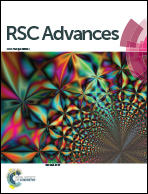Insights into the effect of Pt doping of Cu(110)/H2O for methanol decomposition: a density functional theory study†
Abstract
Density functional theory calculations with the periodic slab model are performed to investigate the mechanism of methanol decomposition with different ratios of Pt doped into Cu(110)/H2O surfaces. Three catalyst models are constructed, denoted 9Pt–Cu(110)/H2O, 3Pt–Cu(110)/H2O and 1Pt–Cu(110)/H2O. Comparing the results with those from experiments conducted on a Cu(110)/H2O surface, the interactions between CH3O and the constructed substrates are weakened, and the adsorption strength of CH2O, CHO and CO is enhanced. The optimal pathway for methanol decomposition on the 9Pt–Cu(110)/H2O surface is CH3OH → CH2OH → CH2O → CHO → CO; the favorable pathway for methanol decomposition on 3Pt–Cu(110)/H2O, 1Pt–Cu(110)/H2O and Cu(110)/H2O surfaces is CH3OH → CH3O → CH2O → CHO → CO. Comparing the activation energies and reaction energies of each step, the Pt dopant promotes the C–H bond scission of CH3O and the dehydrogenation of CH2O, but slightly hinders the O–H bond breaking of CH3OH. In general, monatomic Pt doping into the Cu(110) surface (1Pt–Cu(110)/H2O) can result in excellent catalytic activation considering the price of Pt and the catalyst resistance to CO poisoning. Finally, linear scaling relations for the main elementary steps involved in CH3OH decomposition on 9Pt–Cu(110)/H2O, 3Pt–Cu(110)/H2O and 1Pt–Cu(110)/H2O surfaces are identified.


 Please wait while we load your content...
Please wait while we load your content...